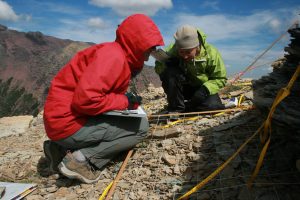Question structure (grammar support)
Part 2: Chapter 7
Questions to consider
A. How does the structure of a question impact its meaning and comprehensibility?
B. How are structurally sound questions used in research writing?
Useful, interesting questions are structured using subjects and verbs. How to compare the variables? is not a complete question as there is neither subject nor main verb. Some well-developed versions of this inquiry are
How can the variables be compared?
How are the variables related?
 The structure of questions
The structure of questions
English speakers rely on the following two common ways to structure questions.
1. Begin with a question word.
A. Where has climate change been documented?
B. When were theories of climate change first developed?
C. Who documented climate change?
Unlike that of a statement, question word order typically follows a verb-subject pattern. Statement versions of questions #A and #B above illustrate this change in word order.
Statement: Climate change has been documented around the world.
A. Where has climate change been documented?
Statement: Theories of climate change were first developed in the early 20th century.
B. When were theories of climate change first developed?
Note: When the subject is unknown, as with “who” questions, the word order does not change.
Statement: Climate change has been documented by scientists.
C. Who documented climate change?
2. Begin with an auxiliary verb (do, have) or the verb “to be”.
A. Do scientists agree on the causes of climate change?
B. Has measurable proof of climate change been documented?
C. Are solutions to the problems of climate change under consideration?
A comparison of these questions and their statement forms illustrates the changes in word order.
Statement: Scientists agree on the causes of climate change.
A. Do scientists agree on the causes of climate change? (begin with form of auxiliary “do”)
Statement: Measurable proof of climate change has been documented.
B. Has measurable proof of climate change been documented? (begin with form of auxiliary “have”)
Statement: Solutions to the problems of climate change are under consideration.
C. Are solutions to the problems of climate change under consideration? (begin with form of “be”)
The auxiliary and “be” verb forms provide tense (explaining when the action happened) and agreement (singular forms with singular subjects, plural with plural).[1]
Examples
- Did scientists agree on the causes of climate change? (past tense)
- Will scientists agree on the causes of climate change? (future tense)
- Does that scientist agree on the causes of climate change? (singular subject)
- Has measurable proof of climate change been documented? (present perfect tense)
- Had measurable proof of climate change been documented? (past tense)
- Have measurable effects of climate change been documented? (plural subject)
- Are solutions to the problems of climate change under consideration? (plural subject)
- Were solutions to the problems of climate change under consideration? (past tense)
- Is a solution to the problems of climate change under consideration? (singular subject)
Language in Action
A. How do questions and answers between these types of speakers differ? Why is that?
- Professional (e.g. physician, lawyer, government official) and client
- Student and instructor, professor or teaching assistant
- Colleagues or academic peers
B. When are questions deployed in writing? How are rhetorical questions different from research questions?
Exercise #1
Choose the strongest version of each question.
Media Attributions
- glacier is licensed under a Public Domain license
- Adapted from Hall, B., & Wallace, E. (2018). College ESL Writers: Applied Grammar and Composing Strategies for Success English Open Textbooks. 14. https://oer.galileo.usg.edu/english-textbooks/14 ↵
a "helping" verb with secondary functions (meaning is a primary function) like expressing tense or number

